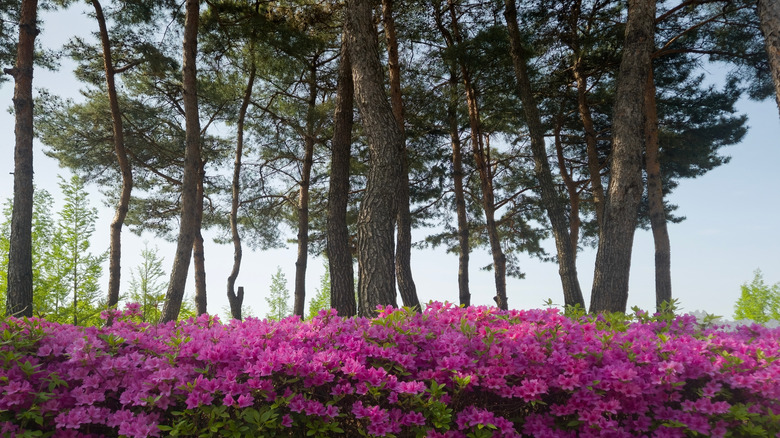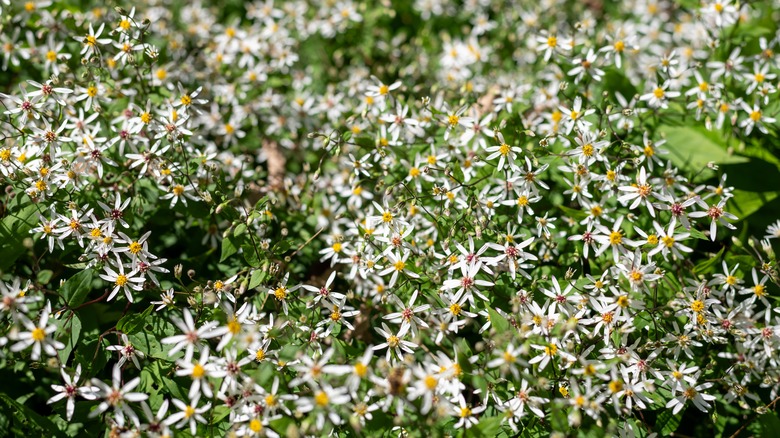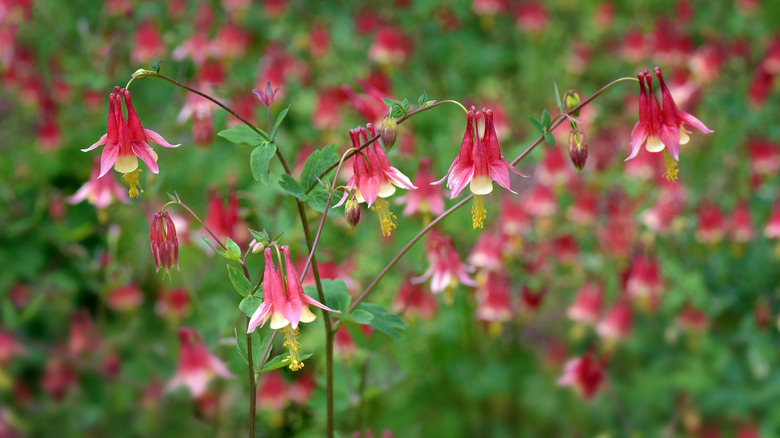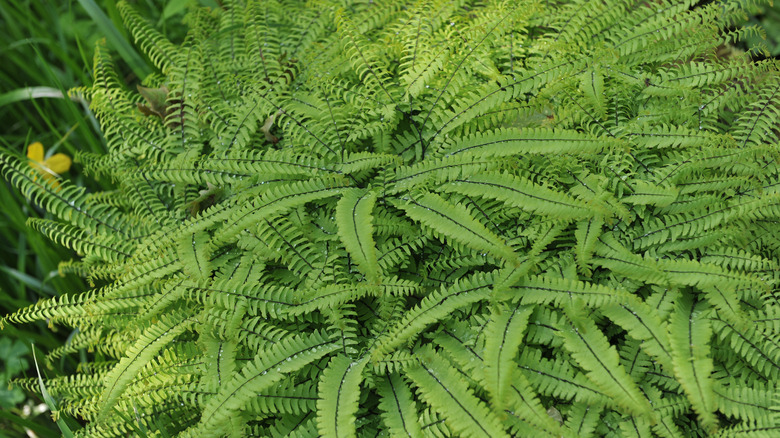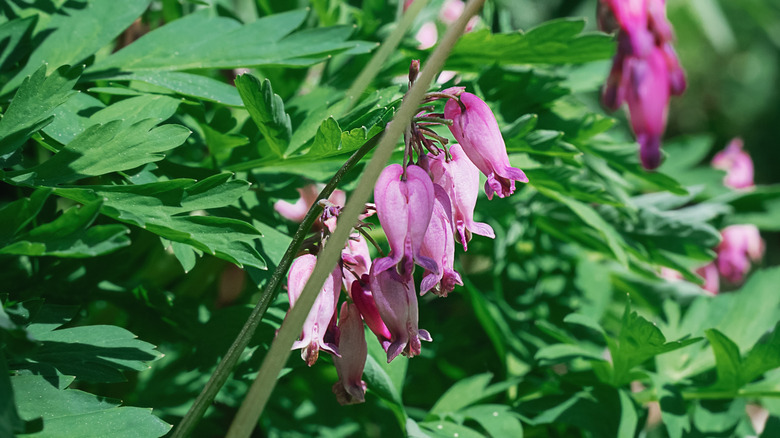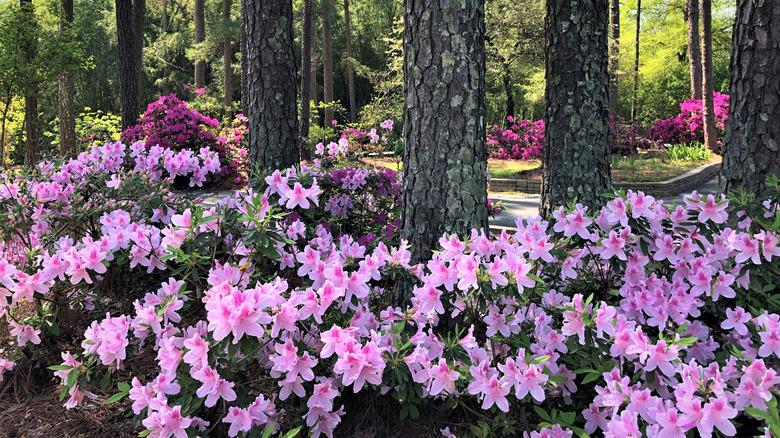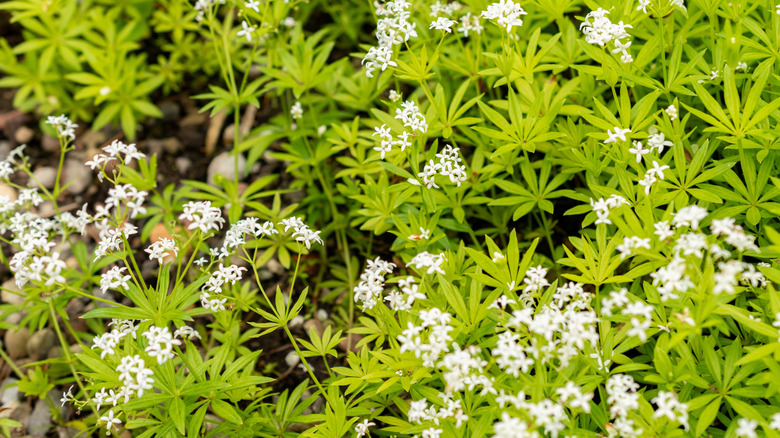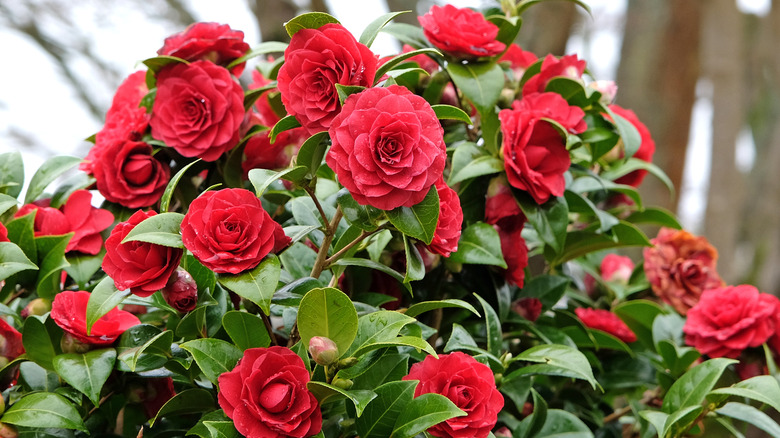10 Companion Plants That Live Happily Under A Pine Tree
If you've ever asked fellow gardeners what you can plant under a pine tree — that is, evergreen conifers or cone-bearing trees, of the genus Pinus — you've probably heard some variation of the old myth that pine trees acidify the soil through their dropped needles. In fact, this is not entirely true. It's unlikely that even a large amount of pine needles, though acidic, will significantly acidify the soil. Rather, it's a simple case of pine trees thriving in acidic conditions, not that they create those conditions themselves. Regardless of cause, the good news is that there are actually a number of plants that are known to thrive in the conditions present beneath pine trees, ranging from low-lift groundcover like sweet woodruff to flowering stunners like azaleas and camellias.
If plant life finds it difficult to thrive beneath a pine tree, they're probably suffering under the shade cast by dense branches and finding it difficult to compete for water and nutrients with the shallow, numerous pine roots. Most plants that can succeed under pines are either acid-loving or acid-tolerant; some thrive in dry conditions with few nutrients, while others embrace the well-drained soil pine trees also tend to prefer. Many options are U.S. natives known to grow wild beneath pine trees in dense forests.
White woodland aster
One uncommon flowering plant that will thrive in dry, acidic soil in full shade? The white wood aster (Eurybia divaricata). Native to dry woods in eastern North America, patches have been observed growing wild beneath conifers like white pine. Considered hardy in USDA Zones 3 through 8, this perennial member of the daisy family spreads via rhizomes to form colonies. With its heart-shaped leaves and abundant white flowers that bloom in summer and fall, it's an attractive ground cover. Plus, the center of the flower changes from yellow to red when they've been pollinated.
Eastern red columbine
Nodding crimson flowers and visually pleasing lobed leaves make eastern red columbine (Aquilegia canadensis) a showstopper ground cover. It's a great addition to a shade garden and will readily grow among pine trees – though it may favor a growing environment that isn't in complete shadow, so maybe consider it as a companion for your smaller or less dense conifers. A self-seeding perennial hardy in zones 3 through 8, it will thrive in a wide range of soil types and conditions. It's a favorite among pollinators and is an especially important food source for ruby-throated hummingbirds.
Northern maidenhair fern
Native to the cool, rich woods and ravines of North America, the perennial northern maidenhair fern (Adiantum pedatum) is a good choice for ground cover beneath pine trees due to its love of shade and acidic soil. Suited to zones 3 through 8, this fern's frilly fronds can grow from 1 to 3 feet tall. It propagates via division or spores, but will also spread on its own via underground rhizomes over time to form colonies. It grows best in humus-y, moist soils, but will also tolerate some drought. Excessive heat may cause leaves to brown.
Pacific bleeding heart
A perennial member of the poppy family native to the woods of North America's west coast — including yellow pine forests — Pacific bleeding heart (Dicentra formosa) is hardy in zones 3 through 8 and favors acidic, loamy soils. Its unique drooping pink-purple heart-shaped blooms come in spring and summer and its lacy, almost fernlike foliage lasts until winter, when it goes dormant. Seed propagation is slow, but established plants will spread via underground rhizomes to create large colonies. It will happily form understory colonies beneath conifers, though it may need a layer of protective mulch during the winters.
Azalea
The acid-loving azalea (Rhododendron spp.) family is one group of plants that actually benefits from the growing conditions in areas beneath pine trees. They provide the filtered partial shade azaleas prefer, while embracing and maintaining the low soil pH that enables them to thrive. Additionally, a good solid pine tree can protect azaleas from the leaf scorch they might suffer in direct wind. As a group, azaleas are generally considered hardy in zones 4 through 8, but a vast array of species, cultivars, and hybrids are available; do some research on which ones might suit your location's characteristics best.
Canada mayflower
Canada mayflower (Maianthemum canadense) is native to North America, where it can be found growing as an understory species in woods and flourishing among pine stands. Hardy in zones 1 through 8, this perennial member of the asparagus family is another acid-and shade-loving species that spreads using rhizomes to form lush carpets of glossy green foliage. Also known as false lily-of-the-valley, it's a great alternative to the sometimes-invasive Eurasian lily of the valley. Its white, star-shaped flowers bloom in late spring and early summer. Although it prefers moist soils, it tolerates some drought.
Sweet woodruff
A sweetly aromatic flowering ground cover, sweet woodruff (Galium odoratum) grows well in dry, acidic, shady spots under your pines. It has visually intriguing leaves arranged in whorls around the stem and small white star-shaped blooms in spring. Well suited to zones 4 through 8, it's a vigorous, dense spreader via rhizomes and seeds. Some gardeners find it aggressive and difficult to eradicate when no longer wanted, but it tends to behave more politely in cooler climates. Its foliage smells of vanilla and fresh hay, and is a lovely addition to potpourri when dried.
American wintergreen
Found growing wild as an understory plant in New England's pine forests — sites of substantial shade and acidic soil — American wintergreen, or teaberry (Gaultheria procumbens), is an evergreen subshrub in the blueberry family. Its edible, bright red berries, which appear in fall after the bell-like flowers drop and can still be found throughout the winter, were originally used (along with the leaves) as the source of wintergreen flavoring for chewing gum. Hardy in zones 3 through 7 and drought resistant, wintergreen will happily spread as attractive groundcover even in heavy shade as long as the soil is well-drained.
Blueberry
Try growing a patch of highbush blueberries (Vaccinium corymbosum) around your pine trees! Blueberries can thrive as companions to pine trees, as they share the acidic, high-organic-matter soil quality that blueberries crave. Just ensure that your blueberry shrubs aren't completely crowded out by a heavy tree population, as they do need some sun and airflow to produce fruit. Ideal for zones 3 through 8, blueberries flower in spring and set fruit in summer. Try planting different cultivars together — the resultant cross-pollination will increase your fruit yield. Plus, different cultivars fruit at different times to extend your harvest season.
Camellia
A common, lovely sight in southern U.S. gardens, camellias are perfectly suited to the filtered shade and acidic soil found beneath many pines. There are a vast variety of camellia species in a riot of blossom colors and forms to explore — and over 40,000 registered cultivars!– from the winter-blooming Japanese camellia (C. japonica) to the tea camellia (C. sinensis var. sinensis), whose leaves have been used for thousands of years to brew tea. Generally hardy in zones 7 through 10, most camellias are plants that benefit from pine needle mulch but need good air circulation directly against the roots.
